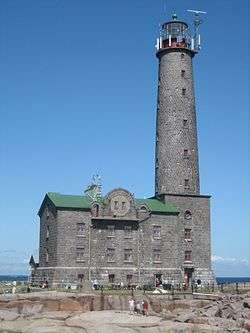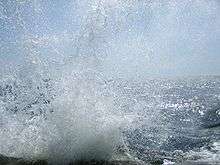Bengtskär
Bengtskär is a skerry in the outer archipelago of the Archipelago Sea in Finland, at the entrance to Gulf of Finland, with the tallest lighthouse in the Nordic countries. It is open for visitors, providing dinners, accommodation and sauna.
Understand

History
The area north of Bengtskär is full of low rocks, very hard to see in the night, at reduced visibility or in ice. When winter traffic with steamships between Stockholm and Hanko began in the 1870s, the need for a lighthouse became more and more apparent. There had been several plans for a lighthouse, but no final decision, when S/S Helsingfors was shipwrecked in the area in 1905. The next year the lighthouse was built, partly using granite from the skerry itself. The light and the huge lenses were made in Paris.
A replika of a jakt (small sailing ship) used to bring building material to the skerry, Eugenia, can be seen in (and sailed from) Västanfjärd, Kasnäs or Dalsbruk in Kimitoön. The original's skipper famously refused to install a motor, so it was one of the last three pure sailing ships in the ship register in the 1950s.
The lighthouse had a crew of five: the master, three keepers and a mist signal operator. With them came their families; in 1910 there were 22 persons living on the skerry.
The lighthouse was evacuated for World War I. During the war two German cruisers fired at the lighthouse, but damages were small.
The lighthouse was likewise evacuated for World War II, but it was used as watch and for control of artillery fire. During the Continuation War, when Hanko was in Soviet hands, the lighthouse became especially important, and a commando was sent to destroy it. The watch consisted of 5–10 men, but 29 more had been sent there recently. A watchman noticed the commando as it had already landed and fierce fighting continued all night and most of the day, soon involving, from the Finnish side, the Örö and Granholmen batteries and later two gunboats, aircraft and 80 more men, who succeeded in landing. The attackers did not succeed in landing reinforcements and had to withdraw their vessels. They bombed the lighthouse most of the next day, but as an anti-aircraft gun was brought in, the island was left alone. All in all 32 Finns got killed and 45 wounded, while presumably some 100 of the attackers got killed, and 28 taken prisoners. As Hanko was evacuated later in 1941 there was no more fighting on the island.
The lighthouse had been severely damaged during the fighting and bombing, and some of the other buildings were destroyed. During the repairs also fortifications were built. The families were left at home and the keepers took turns of a month, later two weeks, with the crew reduced to four. In 1968 the lighthouse was automated.
As no lighthouse keepers lived on the island, the buildings fell in disrepair. The gas light was replaced 1983 by a cheaper and more reliable electric light getting its power from the wind. To stop the deterioration the lighthouse was given for rent in 1985, with duty of repairs and keeping the lighthouse warm.
The first tenant was the non-profit Pro Bengtskär, which failed to get enough long-time funding. 1992 the centre of continuing education of University of Turku took over the responsibility. 1995 the lighthouse was ready to welcome visitors. The lighthouse was bought by the Turku university foundation in 2000. The tourist business is handled by Paula Wilson from Rosala and her family.
Landscape

Bengtskär is one of the outermost islets, facing the open sea to the south. By the northern horizon there are bigger islands of the Archipelago Sea, such as Örö, Rosala and Hitis, and all around there are uncountable tiny rocks and skerries sparsely spread out in the sea – navigating the outer archipelago is not for the faint of heart. The islet itself consists of bedrock and stones, with some vegetation where it can find shelter.
Flora and fauna
As this is a tiny island in the sea, sometimes washed over in violent storms, and with a cold winter, only a limited number of plants and animals live on Bengtskär. Migrating birds often use it for some rest after or before flying over the Gulf of Finland; about half of the Finnish bird species have been observed on Bengtskär. Eiders nest in great numbers, getting protection from predators by the human presence. There are frogs and bats, but no rodents or snakes. Also ticks and biting mosquitoes are absent. The skerry Ytterland 4 km to the west hosts seals, which sometimes pay visits to Bengtskär.
Climate
The climate is moderated by the sea, but the island is still in the north. The sea freezes over more or less every year, sometimes with drifting ice packed on the shore. In the spring temperatures are cooler than on the mainland, while temperatures in the autumn stay mild until the ice sets (although wind chill and spray may not help to make that obvious). On a calm summer's day it may be hot, but with a fresh wind proper clothing is often needed, as is sunscreen and sunglasses on sunny days, due to reflections from the water.
Get in

The normal way of getting in is with cruises from Kasnäs, Kimitoön, via the Viking centre on Rosala, or from Hanko. Usually the cruises are sold as packages with meals, guiding etc. included.
Visitors with their own vessels are welcomed (call in advance to check details), but the skerry is in the hard-to-navigate outer archipelago and there is no safe harbour, so visits are possible only in calm weather. Using the jetty must not interfere with cruise or service traffic. If coming from the sea, you might want to make a call to the coast guard, although there should usually not be any formalities if arriving from a Schengen port (if arriving from Russia or from outside the Baltic, go via a customs port). The boating chart series do not cover the outer archipelago, so you have to buy the normal chart (nr 22, possibly also 24; the small scale overview chart is not enough).
Fees and permits
The island is open for visitors 2 June–26 August (2018), weekend tours May to September. Visitors with own vessel are welcome 10:00–19:00.
Pets are problematic, as there are many nesting birds, easily disturbed by a dog. If you arrive by yacht, leave them aboard.
Entrance fee €8, included in the packages. Children reduction for 4–14 years old: 50 % on entrance, meals and accommodation. Overnight tours from Kasnäs including one lunch and a visit to Rosala Viking Centre €61 in season, add €70–120/person for accommodation, and the price for other meals.
Typical packet price for a stay including transport, meals and accommodation is €400–500 for two persons.
Get around
The skerry is not big, so you get anywhere by foot in a few minutes. Watch your step, though. The place is not very accessible for those with mobility impairments (check if relevant).
See and do

- 🌍 Bengtskär lighthouse. built in 1906
Except seeing the lighthouse itself, you will be admiring the views, walking around the island, spotting birds and possibly seals, and perhaps taking a dip in the cool sea if the weather allows.
Sauna available.
Buy
Some souvenirs available.
Eat and drink
Meals are usually booked together with transport and accommodation. If you arrive by own means, book the meals you want to have. Own snacks are allowed.
Lunch €17.50, dinner €37. Available only if reserved in advance.
Café on site (coffee with bun €6, water €2, beer €5).
Sleep

Lodging is provided in the former lighthouse keepers' rooms, each for 1–4 persons: €70–120/person (room for two: €184). Sauna and breakfast included. There is nowhere to pinch a tent on the rocky island.
Stay safe
The rock can be slippery, especially at the shores. Rescuing somebody from the water is not necessarily easy, especially if there are even moderate waves.
Go next
- Örö, an island in the Archipelago National Park, at the border between outer and inner archipelago, visible in the north-west, is easy to reach from Kasnäs (or en route, if coming with yacht). It is big enough to have forest and meadows, and was a fortress for most of the 20th century.
- The Archipelago Sea, which you got some feel for on your way out, is the boater's paradise. Charter a boat in Kasnäs and explore – or use the ferries on the Archipelago Trail.